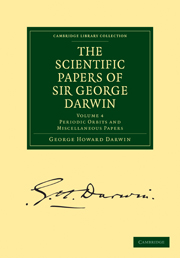Book contents
- Frontmatter
- PREFACE
- Contents
- Chronological List of Papers with References to the Volumes in which they are contained
- Errata
- PART I PERIODIC ORBITS
- PART II THE TIDES
- PART III MISCELLANEOUS PAPERS IN CHRONOLOGICAL ORDER
- 5 On some Proposed Forms of Slide-rule
- 6 An Application of Peaucellier's Cell
- 7 The Mechanical Description of Equipotential Lines
- 8 On a Mechanical Representation of the Second Elliptic Integral
- 9 On Maps of the World
- 10 A Geometrical Puzzle
- 11 A Geometrical Illustration of the Potential of a Distant Centre of Force
- 12 On Graphical Interpolation and Integration
- 13 On a Theorem in Spherical Harmonic Analysis
- 14 On Fallible Measures of Variable Quantities, and on the Treatment of Meteorological Observations
- 15 On the Horizontal Thrust of a Mass of Sand
- 16 On the Formation of Ripple-mark in Sand
- 17 Note on Mr Davison's Paper on the Straining of the Earth's Crust in Cooling
- 18 On the Mechanical Conditions of a Swarm of Meteorites, and on Theories of Cosmogony
- 19 On the Perturbation of a Comet in the Neighbourhood of a Planet
- 20 The Eulerian Nutation of the Earth's Axis
- 21 The Analogy between Lesage's Theory of Gravitation and the Repulsion of Light
- PART IV PAPERS ON TIDES (Supplementary to Volume I)
- PART V ADDRESSES TO SOCIETIES
- APPENDIX
- INDEX
- Plate section
18 - On the Mechanical Conditions of a Swarm of Meteorites, and on Theories of Cosmogony
Published online by Cambridge University Press: 07 September 2010
- Frontmatter
- PREFACE
- Contents
- Chronological List of Papers with References to the Volumes in which they are contained
- Errata
- PART I PERIODIC ORBITS
- PART II THE TIDES
- PART III MISCELLANEOUS PAPERS IN CHRONOLOGICAL ORDER
- 5 On some Proposed Forms of Slide-rule
- 6 An Application of Peaucellier's Cell
- 7 The Mechanical Description of Equipotential Lines
- 8 On a Mechanical Representation of the Second Elliptic Integral
- 9 On Maps of the World
- 10 A Geometrical Puzzle
- 11 A Geometrical Illustration of the Potential of a Distant Centre of Force
- 12 On Graphical Interpolation and Integration
- 13 On a Theorem in Spherical Harmonic Analysis
- 14 On Fallible Measures of Variable Quantities, and on the Treatment of Meteorological Observations
- 15 On the Horizontal Thrust of a Mass of Sand
- 16 On the Formation of Ripple-mark in Sand
- 17 Note on Mr Davison's Paper on the Straining of the Earth's Crust in Cooling
- 18 On the Mechanical Conditions of a Swarm of Meteorites, and on Theories of Cosmogony
- 19 On the Perturbation of a Comet in the Neighbourhood of a Planet
- 20 The Eulerian Nutation of the Earth's Axis
- 21 The Analogy between Lesage's Theory of Gravitation and the Repulsion of Light
- PART IV PAPERS ON TIDES (Supplementary to Volume I)
- PART V ADDRESSES TO SOCIETIES
- APPENDIX
- INDEX
- Plate section
Summary
Mr [now Sir Norman] Lockyer writes in his interesting paper on Meteorites as follows:–
“The brighter lines in spiral nebulæ, and in those in which a rotation has been set up, are in all probability due to streams of meteorites with irregular motions out of the main streams, in which the collisions would be almost nil. It has already been suggested by Professor G. Darwin (Nature, Vol. XXXI., 1884–5, p. 25)—using the gaseous hypothesis—that in such nebulæ ‘the great mass of the gas is non-luminous, the luminosity being an evidence of condensation along lines of low velocity, according to a well known hydrodynamical law. From this point of view, the visible nebula may be regarded as a luminous diagram of its own stream-lines’.”
The whole of Mr Lockyer's paper, and especially this passage in it, leads me to make a suggestion for the reconciliation of two apparently divergent theories of the origin of planetary systems.
The nebular hypothesis depends essentially on the idea that the primitive nebula is a rotating mass of fluid, which at successive epochs becomes unstable from excess of rotation, and sheds a ring from the equatorial region.
The researches of Roche (apparently but little known in this country) have imparted to this theory a precision which was wanting in Laplace's original exposition, and have rendered the explanation of the origin of the planets more perfect.
- Type
- Chapter
- Information
- The Scientific Papers of Sir George DarwinPeriodic Orbits and Miscellaneous Papers, pp. 362 - 431Publisher: Cambridge University PressPrint publication year: 2009First published in: 1911

